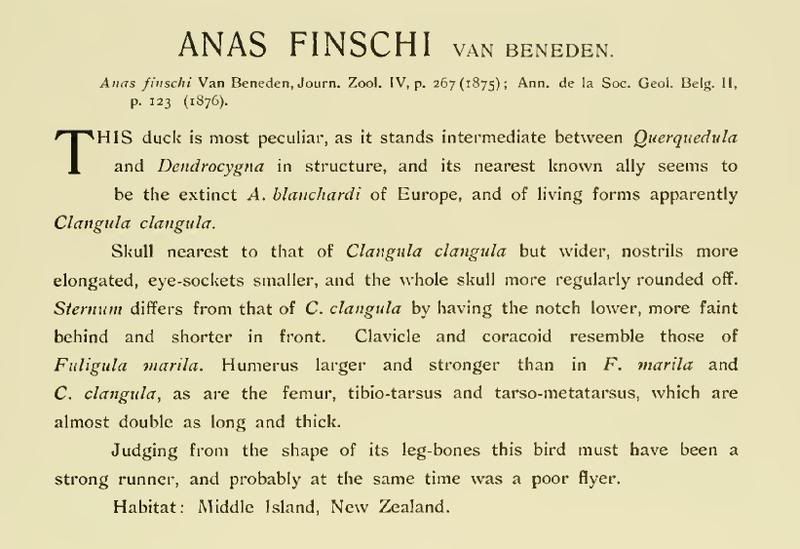|
|
Post by another specialist on Jun 5, 2005 5:42:02 GMT
In about 1870 a boy discovered a cave at Earnscleugh in Central Otago. 2 Men explored the cave soon after and found numerous bird bones. The bones of a duck that we now call Euryanas Finschi were sent to Dr Otto Finsch in Germany who passed them to Professor Van Beneden. The description of the new duck was published in 1875 and Van Beneden named it after Finsch.
Bones found widely in the north and south islands occuring in Maori kitchen middens.
|
|
|
|
Post by Melanie on Jun 5, 2005 21:13:56 GMT
|
|
|
|
Post by Melanie on Jun 5, 2005 21:20:36 GMT
Euryanas finschi (Finsch's duck) (Group I) Abundant throughout in forest and scrub. Flight poor. Food: invertebrates, fallen fruit. Nests built in cavities, under logs, or in cave entrances. Eggs and chicks vulnerable to rat predation. Rats competed for food. Much habitat lost with removal of drier eastern forests. from a very good pdf file about extinct birds in New Zealand www.nzes.org.nz/nzje/free_issues/NZJEcol12_s_11.pdfAt present the only smaller bird dated directly by radio-carbon is Euryanas finschi at 1080 ± 70 yBP (NZ 4166) from Waikari, North Canterbury (McCulloch, 1977). 1950 (BP) - 1150 (years back) = 800 AD (extinction date) |
|
|
|
Post by another specialist on Jun 6, 2005 3:58:48 GMT
Euryanas finschi
(Van Beneden) 1875
Holocene of New Zealand
Primary materials: Types: Cranium, sternum, pelvis, coracoïdeum, scapula, ulna, radius, metacarpus, femur, tibiotarsus, tarsometatarsus, humerus, furcula, fibula, phalanx 1, toes, vertebrae
Bradley C. Livezey,
A phylogenetic classification of waterfowl (Aves: Anseriformes), including selected fossil species
Annals of Carnegie Museum 66 (1997): 457-496
|
|
|
|
Post by another specialist on Nov 2, 2005 9:57:03 GMT
|
|
|
|
Post by cryptodude100 on Jun 5, 2006 12:21:29 GMT
It was about the size and body mass of the extant grey duck (Anas superciliosa), but with more robust legs and smaller wings.
|
|
|
|
Post by dysmorodrepanis on Aug 12, 2006 17:33:03 GMT
Now put into genus Chenonetta.
|
|
|
|
Post by dysmorodrepanis on Aug 20, 2006 22:01:16 GMT
|
|
|
|
Post by sebbe67 on Dec 30, 2006 13:17:08 GMT
|
|
|
|
Post by another specialist on Dec 31, 2006 10:10:54 GMT
 New Zealand Extinct Birds Brian Gill and Paul Martinson |
|
|
|
Post by another specialist on Jul 19, 2008 19:06:22 GMT
 Extinct birds : an attempt to unite in one volume a short account of those birds which have become extinct in historical times : that is, within the last six or seven hundred years : to which are added a few which still exist, but are on the verge of extinction (1907) |
|
|
|
Post by another specialist on Jul 27, 2008 4:52:03 GMT
|
|
|
|
Post by another specialist on Jul 27, 2008 5:02:21 GMT
|
|
|
|
Post by another specialist on Jul 27, 2008 5:04:35 GMT
|
|
|
|
Post by another specialist on Jul 27, 2008 5:10:19 GMT
|
|
|
|
Post by another specialist on Jul 27, 2008 5:12:01 GMT
|
|
|
|
Post by another specialist on Jul 27, 2008 5:14:48 GMT
|
|
|
|
Post by another specialist on Jul 27, 2008 5:16:32 GMT
|
|
|
|
Post by another specialist on Sept 8, 2008 11:46:48 GMT
  The Lost World of the Moa By T. H. Worthy, Richard N. Holdaway, Rod Morris |
|
Deleted
Deleted Member
Posts: 0
|
Post by Deleted on May 1, 2014 7:59:17 GMT
Hi there!
Samuel T. Turvey in 'Holocene Extinctions' gives an date of 1953 (AD!!!) as extinction date for this bird (calibrated date not yet puplished)!
Despite having this book for some time I only discovered that date two or three days ago, this can only be an error, right?
|
|